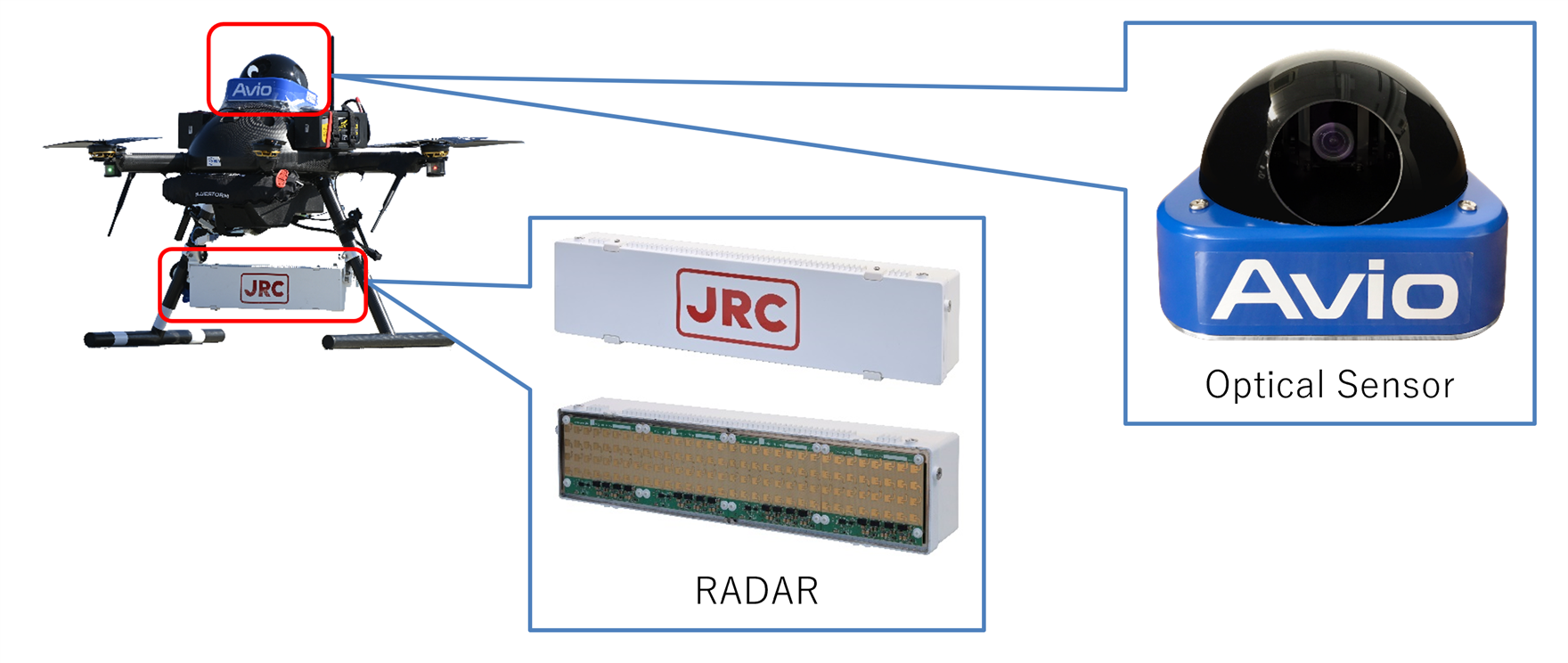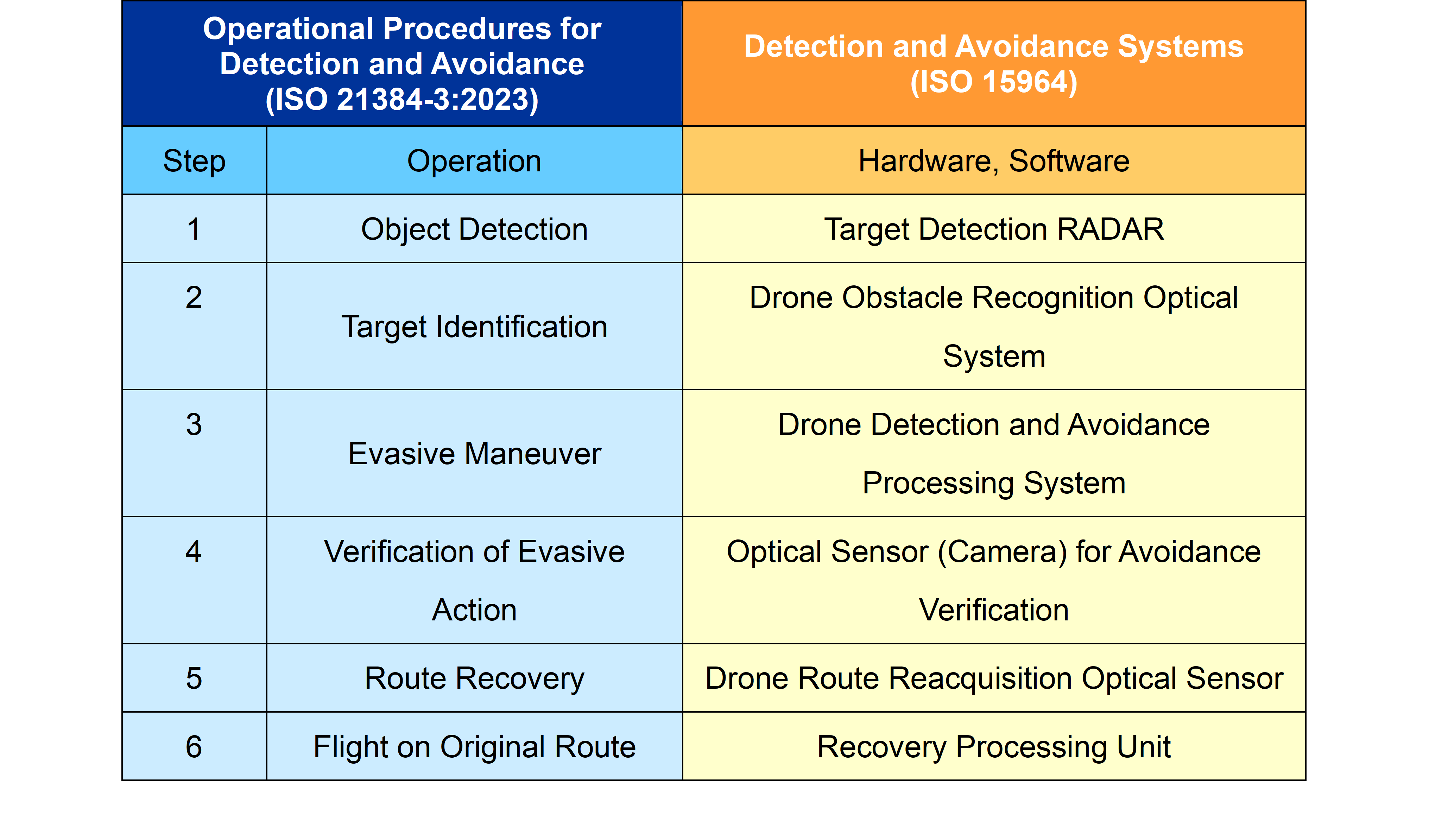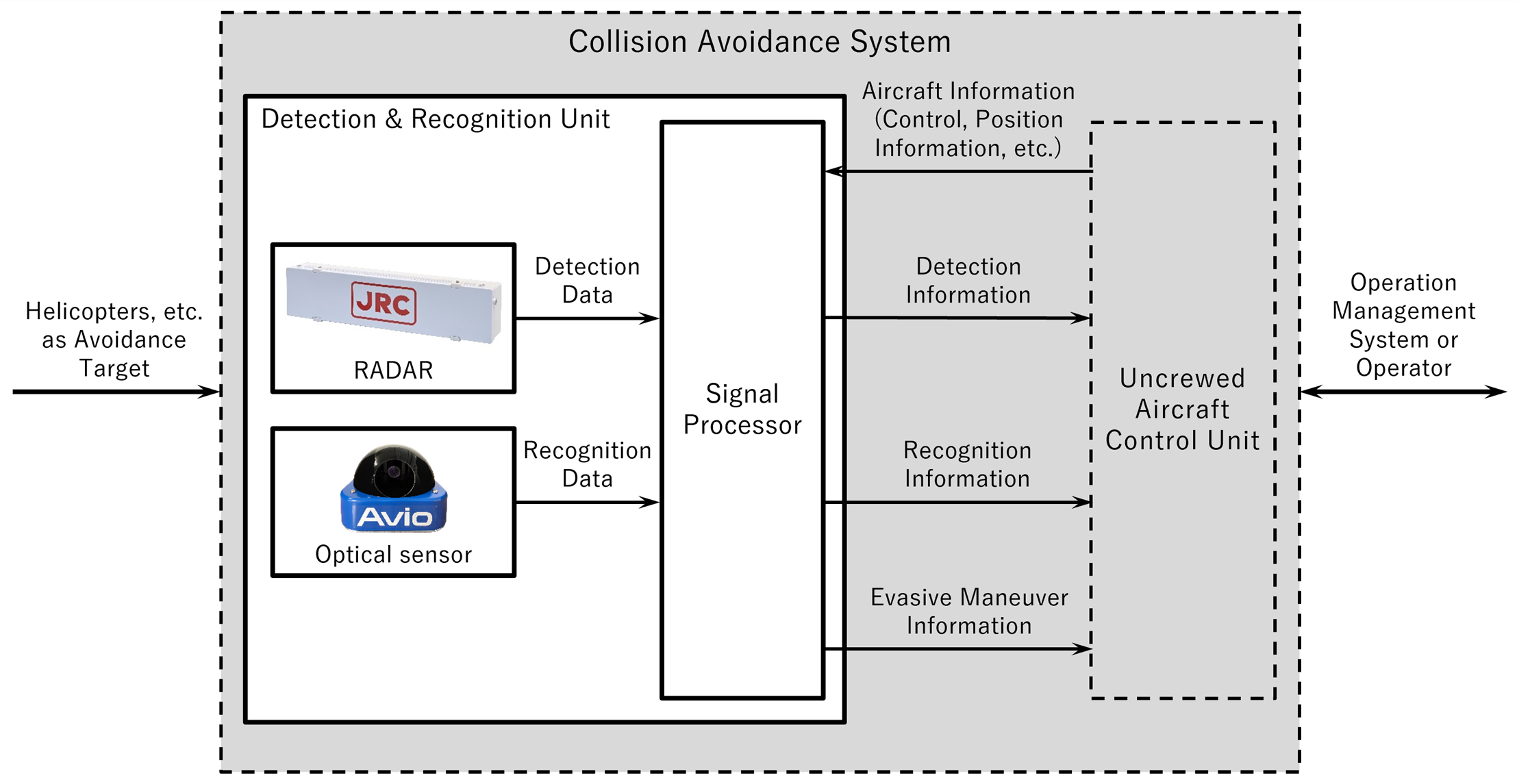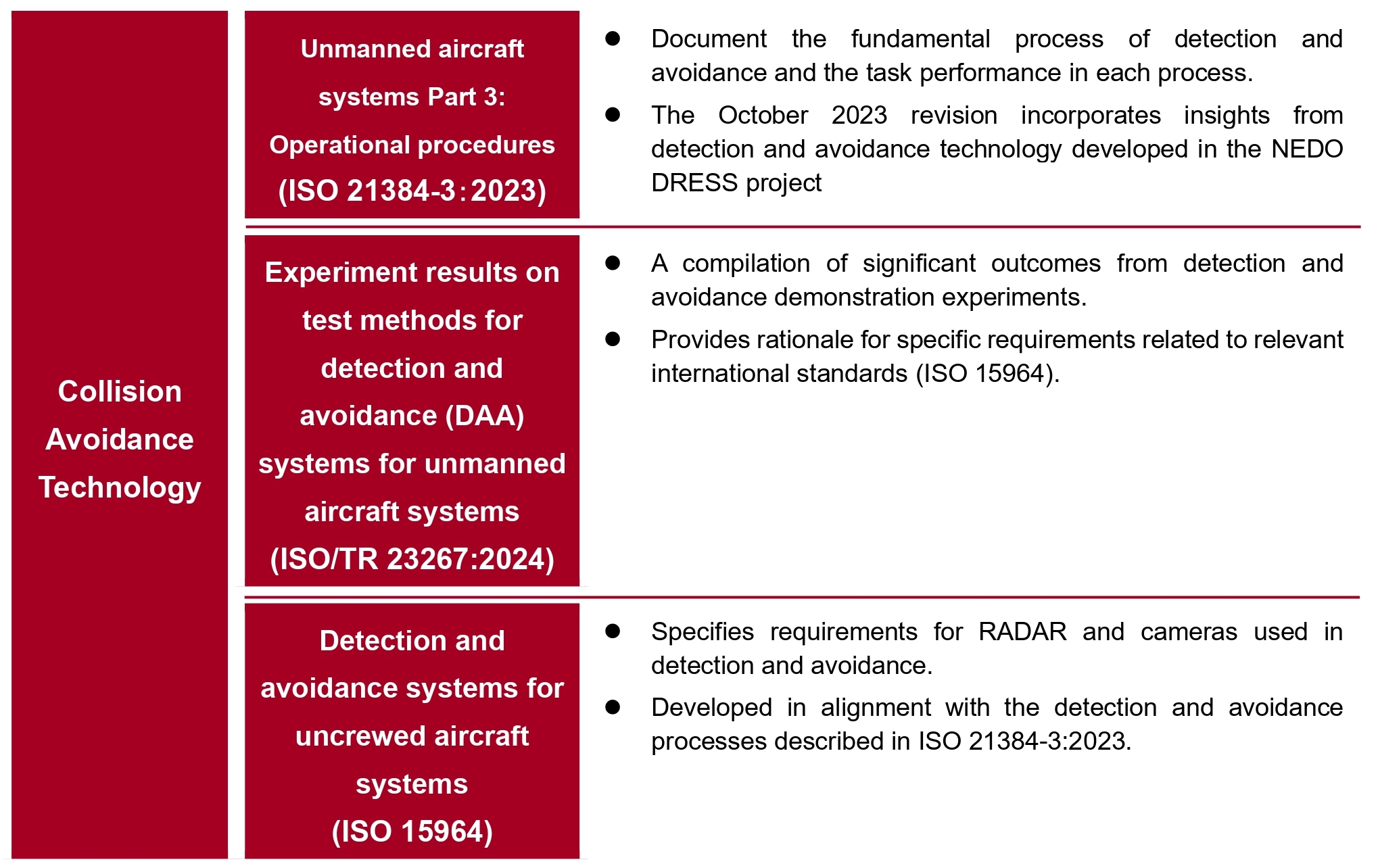International Standard ISO15964 Released
— NEDO Research and Development Results Contributed to System Standardization —
June 12, 2025
New Energy and Industrial Technology Development Organization (NEDO)
JAPAN RADIO CO., LTD.
NIPPON AVIONICS CO., LTD.
ACSL LTD.
MITSUBISHI RESEARCH INSTITUTE, INC.
Based on the results of NEDO's commissioned project "Robot and Drone Utilization for Creating an Energy-Efficient Society Project" (hereinafter referred to as the "NEDO DRESS Project"), Japan Radio Co., Ltd., Nippon Avionics Co., Ltd., ACSL Ltd., and Mitsubishi Research Institute, Inc. have been contributing to the standardization of detection and avoidance systems for uncrewed aircraft.
On April 25, 2025, the International Organization for Standardization (ISO) officially released the international standard for uncrewed aircraft detection and avoidance systems as "ISO15964 Detection and avoidance systems for uncrewed aircraft systems" (hereinafter referred to as "this standard"). This standard specifies the requirements for sensors and other components used in detection and avoidance systems that implement "ISO21384-3 Unmanned aircraft systems—Part 3: Operational procedures." Japan contributed use cases for detection and avoidance with manned helicopters, which were based on the technical report "ISO/TR 23267: Experiment results on test methods for detection and avoidance (DAA) systems for unmanned aircraft systems." This report compiled various demonstration experiment results from the NEDO DRESS Project.
Going forward, drone stakeholders who have independently developed detection and avoidance technologies, conducted operational demonstrations, and explored business opportunities can now align their efforts with this standard. This will accelerate global information sharing, technology development, and social implementation. The international standardization of detection and avoidance systems between uncrewed aircraft and other aircraft, or between uncrewed aircraft themselves, will harmonize technological development and accelerate implementation efforts across countries, leading to the realization of a wide range of services.

Figure 1: Examples of sensors developed in the NEDO DRESS Project
1. Background
- Small to medium-sized uncrewed aircraft, commonly known as drones, are already widely used in the agricultural sector and are expected to play a significant role in transporting supplies during disasters, searching for missing persons, and logistics infrastructure. However, in Japan, there have been reports of near-misses*1 between uncrewed aircraft and manned aircraft such as medical helicopters making detection and avoidance an urgent safety issue for uncrewed aircraft.
- The NEDO DRESS Project*2 began developing detection and avoidance technology for uncrewed aircraft in fiscal 2017 and carried out demonstration trials through fiscal 2021, resulting in multiple research and development outcomes related to detection and avoidance technology.
- In October 2023, a detection and avoidance CONOPS (Concept of Operations) was added as a new chapter to "ISO 21384-3:2023 Unmanned aircraft systems Part 3: Operational procedures*3," based on these results and proposals from Japan. This new chapter outlines a basic six-step procedure for detection and avoidance. Furthermore, the technical report ISO/TR 23267*4 was published on April 15, 2024.
2. Results of the NEDO DRESS Project
- This standard, ISO 15964*5, specifies the basic architecture of detection and avoidance systems that implement the basic six-step procedure defined in ISO 21384-3:2023. These steps are "Object detection," "Target recognition," "Avoidance maneuver," "Confirmation of avoidance results," "Return to original route," and "Flight on original route."
- Furthermore, this standard is designed to support a range of applications, including short-range and medium- to long-range detection and avoidance systems. Japan incorporated responses to medium to long-range use cases assuming detection and avoidance with manned aircraft. Specifically, the standard defines the roles of various sensors and the detection/recognition distances for each of the six steps in the detection and avoidance CONOPS. These specifications apply to systems equipped with RADAR and optical sensors mounted on uncrewed aircraft.
Table 1: Hardware and software used in the six-step detection and avoidance process


Figure 2: Basic architecture of medium to long-range detection and avoidance systems
- The requirements for sensor roles and their detection and recognition distances are based on ISO/TR 23267. This technical report was proposed by Japan and compiled by Japan Radio Co., Ltd. and Mitsubishi Research Institute, Inc., from various demonstration trials, research and development outcomes from the NEDO DRESS Project.
- Additionally, the standard specifies an architecture that relies solely on optical sensors for use cases involving small, uncrewed aircraft that cannot carry RADAR. It defines the roles and detection/recognition distances of various sensor equipment in the six steps of detection and avoidance CONOPS based on the evidence in ISO/TR 23267.
Table 2: Reflection of NEDO DRESS Project results in ISO standards

*Created by Japan Radio Co., Ltd. based on the FY2023 Results Report: Information Collection Costs/Survey of Cases Contributing to Strategic Use of Standards at NEDO. Materials can be obtained from the following URL:(https://www.nedo.go.jp/seika_hyoka/database_index.html)
Table 3: Role distribution among companies

3. Social Impact of the Results
- With the standardization of detection and avoidance procedures and the systems that implement them based on supporting documents, regulatory authorities are expected to accelerate legislation efforts. This will further enhance airspace safety and contribute to the realization of an energy-efficient society in which drones play an active role across a wide range of applications.
[Notes]
- *1 Examples of near-misses with manned aircraft
Refer to p.16 of " detection and avoidance Measures for Aircraft and Uncrewed Aircraft, and Between Uncrewed Aircraft (Ministry of Land, Infrastructure, Transport and Tourism, Civil Aviation Bureau, November 8, 2016)."
https://www.mlit.go.jp/common/001153086.pdf(725KB) - *2 NEDO DRESS Project
A project promoted by NEDO from 2017 to fiscal 2022, consisting of four items: [1] Development of performance evaluation standards for robot and drone aircraft, [2] Development of uncrewed aircraft operation management systems and detection and avoidance technology, [3] Promotion of international standardization related to robots and drones, and [4] Leading research on flying cars, aiming to realize an energy-efficient society.
Project overview:https://www.nedo.go.jp/activities/ZZJP2_100080.html - *3 ISO 21384-3:2023 Unmanned aircraft systems Part 3: Operational procedures
Overview:https://www.iso.org/standard/80124.html
(Reference) NEDO release "Japan's proposal on uncrewed aircraft detection and avoidance adopted and published in revised
international standard" (October 6, 2023)
https://www.nedo.go.jp/news/press/AA5_101696.html - *4 ISO/TR 23267
Overview:https://www.iso.org/standard/87386.html
(Reference) NEDO release "Technical report on uncrewed aircraft detection and avoidance from Japan published by ISO" (April 22, 2024)
https://www.nedo.go.jp/news/press/AA5_101740.html - *5 ISO 15964
Overview:https://www.iso.org/standard/84450.html
4. Contact Information
(For inquiries regarding the content of this news release)
NEDO Aerospace Department E-mail: aero_admi[*]ml.nedo.go.jp
Japan Radio Co., Ltd., Business Promotion Department, Marketing & Public Relations Group, E-mail: pr[*]jrc.co.jp
Nippon Avionics Co., Ltd., Corporate Planning Division, Planning Department
https://www.avio.co.jp/contact/
ACSL Ltd., Public Relations TEL: 03-6456-0931
Mitsubishi Research Institute, Inc., Mobility and Communications Division TEL: 03-6858-3729
* To send an inquiry by email, please replace [*] with @ in the above email address.
*When introducing our organization in newspapers, TV, etc., please use "NEDO (New Energy and Industrial Technology Development Organization)" or "NEDO".
